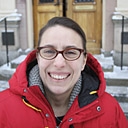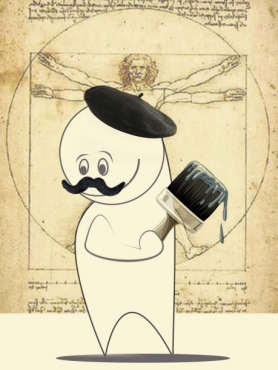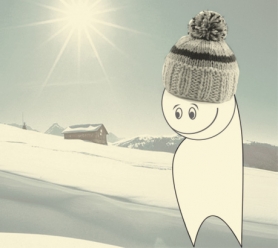Growing Västerbotten (HDL x UID)
-
Umeå Institute of Design invited us to lead a workshop as part of the school's Prototyping the Future experiment, a week where the school is trying out new design practices. We jumped at the opportunity to try out the HDL Studio model in a much different setting and to expose a new group of young designers to the possibility of strategic work.
-
Working with the County of Västerbotten which is home to Umeå and the university, we asked the students to develop ideas that help Västerbotten attract and retain its current and future residents. Starting with a small pile of PDFs and a day of lectures the students jumped in head first to make sense of the structural issues at play in the county and develop a set of ideas to expand the potential of the region.
-
Sitra staff Marco Steinberg, Justin Cook, and Bryan Boyer acted as tutors for the workshop. The work you see on this page is that of the student team and does not necessarily represent the views of Sitra/HDL.
-
Meet the team!
-

Andrew Schaper
Industrial Design Introduction student
-

Anton Garland
Transportation Design student
-

Daniel Gunnarsson
Transportation Design student
-

Daniela Rothkegel
PhD student in Interdisciplinary Innovation in transportation
-

Kerem Erdem Göç
Advanced Design Visualization student
-

Michael Edenius
Industrial Design Bachelors student
-
Final Presentation
-
3 Problems
-
The county is opaque
There's a lot of beautiful things on offer here but it can be hard to know how to take advantage of everything.
Swedish modesty is a beautiful thing in one sense, but it's contributing to the opacity of the county. We feel there's a lot to boast about.
-
Things feel disconnected
A lot of attention is given to how distant Västerbotten is from the rest of Sweden, but we're interested in how it feels disconnected within itself. Let's focus on east-west in addition to north-south connections.
-
It's not easy to give back
Umeå has a lot of students but it's not always clear how we can contribute back while we're here.
-
3 Opportunities
-
Västerbotten is a people not a place
Although the county is diverse and beautiful, what's most unique about this place is the people. Especially the way it supports alternative people and the diversity of the society.
-
Choose your own life
This is a place where you have choices. It's cheaper than Stockholm and easier to settle in to. No matter what your economic background or your life choices, this place of opportunity.
-
Rural and City
You don't have to choose between rural or city, here you can have both. It's a big city with a small town feel.
-
10 Ideas for action
-

We think the best way to CARE about VÄSTERBOTTEN is to NOT JUST FOCUS ON ITSELF!
Administrative boundaries don't help. Collect shared potential of the Top of Europe.
-

Can Umeå be the CENTER for TOP OF EUROPE?
Is Västerbotten strong enough to commit to that?
-

Make Västerbotten easy to access!
In business, tourism and logistics a transition from INFORMATION to ACTION needs to happen. Make it easy for people to visit, migrate, start businesses, and more by thinking in a human-centric way.
-

Build shared office centers
Small companies utilize shared office space as a way to keep monthly overhead manageable, making it easier for business to start up. Locating shared offices in the city center could create a meeting point for freelancers, clients and customers. It could be an opportunity to share knowledge, make new connections, and increase collaboration.
-

Where’s the Beach?!
Västerbotten has a beautiful coastline but you need a boat to find it. The coast is under represented to the public. Find ways to get better access to the beaches by bus. Update transportation info to advertise activities on the coast.
-

Local government creates a competition for the 'Umeå Immigration Pathway' system
Full design of new Umeå-based Immigration Centre/Tax office situated at Ersboda. Design an approach that promotes easy integration of immigrants and students into Västerbotten society.
-

Enjoy the snow!
Västerbotten is so different during Summer and Winter that it could almost have two maps. Frozen lakes and rivers are creating new areas and linking streets together during the Winter. Bring the city alive in the darkness with lighting and festivals that make creative use of the ice and snow.
-

The Edible Embassy
An embassy need not have merely a political face; let it have a nourishing one too. Food is an extremely tangible way to connect outsiders to a distant place. Create eateries in Sweden or beyond that are unfamiliar with the culinary opportunities available from Västerbotten. These cafes can be permanent establishments or pop-ups.
-

Mat är People! / Food is People
The way to a person’s heart is through their stomach. Revive the Bagarstugars of Norrland and open communal ovens where locals can bake the traditional baked goods of the region and members of the community with different baking traditions can share their heritage. Or make the fika tradition open and communal by hosting them in public spaces.
-

EU student working scholarship scheme
An approach to encourage EU students to stay in Västerbotten and give local companies a boost in recruiting the high quality students from of Umea University. Student signs a contract to work during summer and a compulsory period of three years work after graduation for the sponsoring business.
-
We ended the week by hosting a final review with the Governor and some of her staff, which was a chance to explore the students' work and how it might fit into the needs and county's ongoing efforts to design a development strategy. As tutors we would like to take the opportunity to reflect on the proposals and offer a brief critique of our own.
Without any previous experience in strategic design the group had a steep learning curve and a lot to process but their response was admirable. Their ability to pull together a strong presentation was impressive!
Becoming comfortable with strategic research and analysis, and especially becoming able to do it in a compressed timeline, takes practice and is rarely taught in design schools. While these comments are meant as a critique of the students' efforts, they are in not identifying failures because the work the students were doing is partially outside of their training. Rather, the critique is intended to act as encouragement to develop their skills and hopefully provide some direction to do so.
We want to remind the students of the strength of their training as designers and suggest that they might lean on this background when approaching new topics, such as this Studio. The proposals depicted here were often missing speculation of the economic, political, and temporal consequences. Even if done on a superficial level, this kind of background is what decision makers will need to have confidence that the ideas could actually gain traction. Here we encourage designers to think of their ability to sketch as a strategy for working with incomplete information. The challenge in strategic design is to learn how to sketch projectively in economics, sociology, etc.
-
To be fair, the studio was also at a disadvantage by being a homogenous group of designers without other deep expertise to draw on. Nevertheless, they dove into the challenge without fear. The resulting analysis is clearly from a student perspective with a slight over-emphasis on the city of Umeå itself and the potential role of students, but this is not without merit given the size of the student body and the importance of Umeå as a regional anchor.
Overall the presentation is light on analysis which blunts the insightfulness of some of the claims. We encourage the students to focus on merging analysis with illustration. The work presented here is illustrated by visual imagery that tells a compelling narrative and the recommendations would be even stronger if it also included analysis, especially in visual form.
This is relevant to problem statements, such as the identification of the last mile problem with public transportation to Västerbotten's beaches, which would benefit from support in the form of maps or analysis of timetables. It's also a critique of the manner in which the ideas for action are presented, which would gain credibility if buffeted by comparative examples that help clarify the precise opportunities for the County and how they are unique from competing places in Sweden and abroad. For instance, what kind of economic effects have co-working spaces in other places created?
—Bryan Boyer & Justin W. Cook
-
Schedule
-
Monday
12.?? Marco's introduction
13.00 - 13.05 Chris Heister - short introduction
13.05 - 14.30 Thomas Westerberg - "Should I Stay or Should I Go - Net migration and demographic change"
14.30 - 16.00 Lars Westin - Perspectives on the Development of Northern Sweden
16.00 - 17.00 Birgitta Heijer och Helena Österlind We will give a complement perspective depending on what the first to speakers have talked about, for example A gender perspective.
-
Tuesday
09:00-12:00 Synthesis session: what do we know?
12:00-14:00 Lunch
14:00-18:00 Field visits / fact finding
-
Wednesday
09:00-12:00 Synthesis session: what do we know?
12:00-13:00 Lunch
13:00-18:00 Field visits / fact finding / synthesis
-
Thursday
09:00-12:00 Synthesis session: what do we know?
12:00-13:00 Lunch
13:00-18:00 Synthesis / drafting presentation
-
Friday
09:00-11:00: Finalizing presentation
11:00-13:00: Final presentation
13:00-15:00: Conversation
+
Guests:
Chris Heister, Governor, County Administrative Board of Västerbotten
Birgitta Heijer, Vice Governor, County Administrative Board of Västerbotten
Helena Österlind, Director of Gender Equality, County Administrative Board of Västerbotten
Margareta Pihlgren, Journalist, County Administrative Board of Västerbotten
Gunialla Lindner, Chamber of Commerce of Västerbotten
-

Out and about in Umeå
-

One of many synthesis sessions
-

Working hard
-

-

The Governor kindly invited us to lunch at her official residence after the presentation.
-
Briefing content
-
Big questions:
How can we get people to move to Västerbotten?
How do we encourage people to stay in Västerbotten?
-
Facts about Västerbotten 2010
Facts about Västerbotten 2010
-
OECD Review
OECD Territorial Review of Sweden from 2010
-
Unexpected Contrasts
Västerbotten: Unexpected Contrasts
-
Västerbotten Population 2008-2009
Bjurholm 2500
Dorotea 2900
Lycksele 12427
Malå 3295
Nordmaling 7205
Norsjö 4361
Robertsfors 6880
Skellefteå 71770
Sorsele 2743
Storuman 6227
Umeå 114075
Vilhelmina 7156
Vindeln 5519
Vännäs 8357
Åsele 3133
Västerbotten Total 258548
Source: Heijer Birgitta
-
Västerbotten's Demographic Challenge
The Demographic Challenge - A Regional Introduction.
-
JämLYS 2008 (in Swedish)
JämLYS 2008 — En jämställdhetsanalys av Övre Norrland
-
Västerbotten 2030 (in Swedish)
Västerbotten 2030
-
Counties & Municipalities (in Swedish)
Västerbottens Län & Kommuner — Västerbotten municipalities
-
Gender Demographics (in Swedish)
Kvinnor och män i belysning 2010 Västerbottens län — Gender Demographics in Västerbotten
-
JämLYS 2010 (in Swedish)
JämLYS 2010 – En jämställdhetsanalys av näringslivet iVästerbotten
